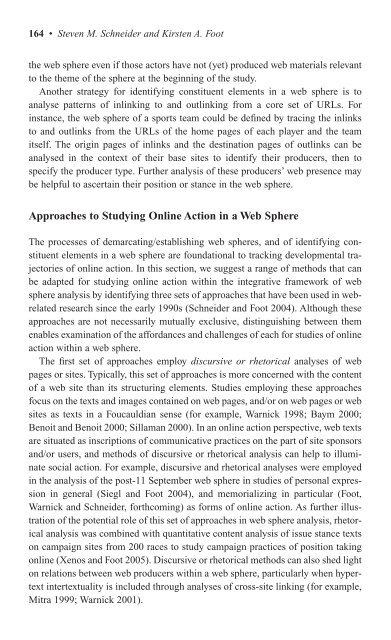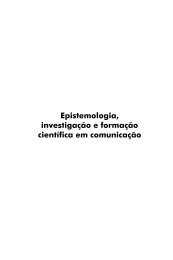Virtual Methods
Virtual Methods
Virtual Methods
You also want an ePaper? Increase the reach of your titles
YUMPU automatically turns print PDFs into web optimized ePapers that Google loves.
164 • Steven M. Schneider and Kirsten A. Foot<br />
the web sphere even if those actors have not (yet) produced web materials relevant<br />
to the theme of the sphere at the beginning of the study.<br />
Another strategy for identifying constituent elements in a web sphere is to<br />
analyse patterns of inlinking to and outlinking from a core set of URLs. For<br />
instance, the web sphere of a sports team could be defined by tracing the inlinks<br />
to and outlinks from the URLs of the home pages of each player and the team<br />
itself. The origin pages of inlinks and the destination pages of outlinks can be<br />
analysed in the context of their base sites to identify their producers, then to<br />
specify the producer type. Further analysis of these producers’ web presence may<br />
be helpful to ascertain their position or stance in the web sphere.<br />
Approaches to Studying Online Action in a Web Sphere<br />
The processes of demarcating/establishing web spheres, and of identifying constituent<br />
elements in a web sphere are foundational to tracking developmental trajectories<br />
of online action. In this section, we suggest a range of methods that can<br />
be adapted for studying online action within the integrative framework of web<br />
sphere analysis by identifying three sets of approaches that have been used in webrelated<br />
research since the early 1990s (Schneider and Foot 2004). Although these<br />
approaches are not necessarily mutually exclusive, distinguishing between them<br />
enables examination of the affordances and challenges of each for studies of online<br />
action within a web sphere.<br />
The first set of approaches employ discursive or rhetorical analyses of web<br />
pages or sites. Typically, this set of approaches is more concerned with the content<br />
of a web site than its structuring elements. Studies employing these approaches<br />
focus on the texts and images contained on web pages, and/or on web pages or web<br />
sites as texts in a Foucauldian sense (for example, Warnick 1998; Baym 2000;<br />
Benoit and Benoit 2000; Sillaman 2000). In an online action perspective, web texts<br />
are situated as inscriptions of communicative practices on the part of site sponsors<br />
and/or users, and methods of discursive or rhetorical analysis can help to illuminate<br />
social action. For example, discursive and rhetorical analyses were employed<br />
in the analysis of the post-11 September web sphere in studies of personal expression<br />
in general (Siegl and Foot 2004), and memorializing in particular (Foot,<br />
Warnick and Schneider, forthcoming) as forms of online action. As further illustration<br />
of the potential role of this set of approaches in web sphere analysis, rhetorical<br />
analysis was combined with quantitative content analysis of issue stance texts<br />
on campaign sites from 200 races to study campaign practices of position taking<br />
online (Xenos and Foot 2005). Discursive or rhetorical methods can also shed light<br />
on relations between web producers within a web sphere, particularly when hypertext<br />
intertextuality is included through analyses of cross-site linking (for example,<br />
Mitra 1999; Warnick 2001).



